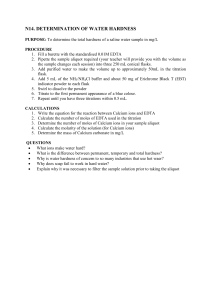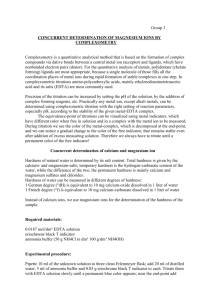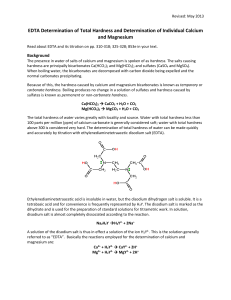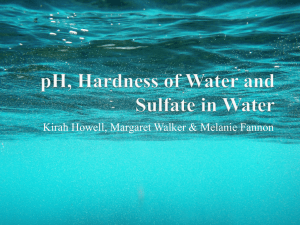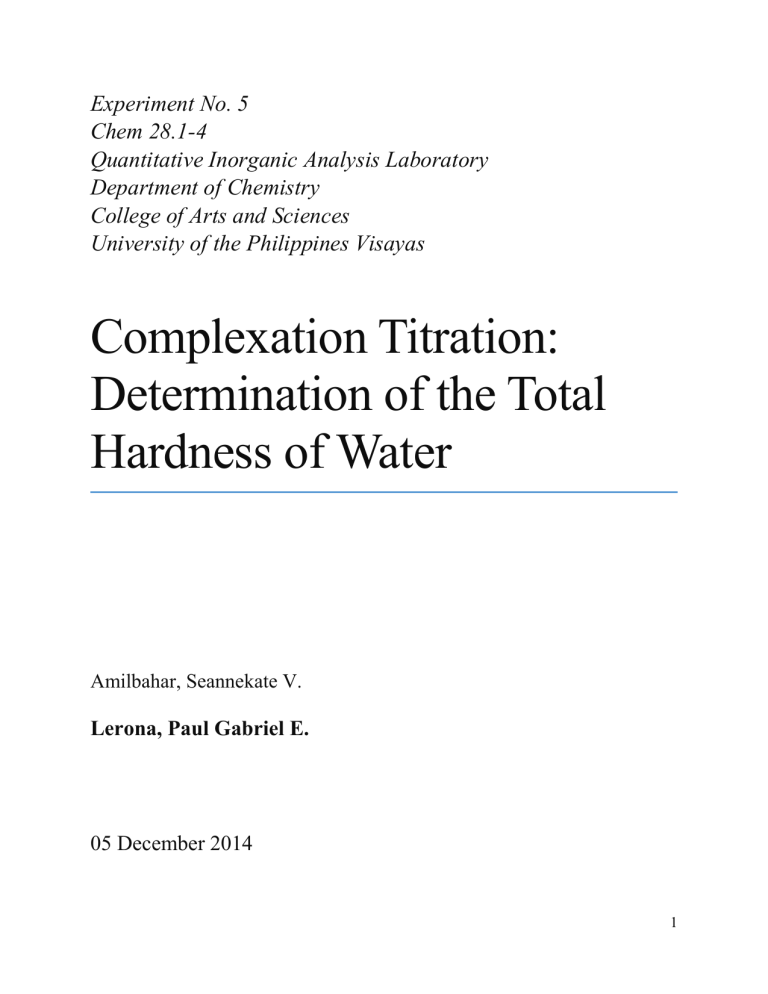
Experiment No. 5 Chem 28.1-4 Quantitative Inorganic Analysis Laboratory Department of Chemistry College of Arts and Sciences University of the Philippines Visayas Complexation Titration: Determination of the Total Hardness of Water Amilbahar, Seannekate V. Lerona, Paul Gabriel E. 05 December 2014 1 COMPLEX FORMATION TITRATION: DETERMINATION OF THE TOTAL HARDNESS OF WATER Amilbahar, S.V., Lerona, P.G.E. ABSTRACT The purpose of this experiment is to determine the total hardness of water at the university’s Chemistry Laboratory using a standardized titrant, ethylenediaminetetraacetic acid, by applying the principles of complexometric and displacement titrimetric analysis. Using five drops of Eriochrome Black T as the indicator, the molarity of EDTA was determined by titrating it with the standard CaCl2 solution using 99.0% pure CaCO3 as the primary standard. Then, a 100.0-mL water sample was obtained from the faucet in the laboratory sink and was titrated with EDTA solution to determine its total hardness. According to American Water Works Association (Hem, 1985), an ideal water should not contain more than 80 mg/L. However, in this experiment, an average of 188.95±3.53 mg CaCO3/L was calculated indicating the water is very hard. This implies that the water system in the laboratory should be treated to avoid further plumbing problems, but this does not necessarily implies that it imposes a health risk, it is could be only alarming if other heavy metals are present, thus, further tests should be done. 2 INTRODUCTION The formation of complexes or coordination compounds is formed when most metals react with electron-pair donors, or ligands. Titrations that are based on complex formation are called complexometric titration. A useful application of complexation titration is the determination of the amount of calcium and magnesium in water, that is, the hardness of water. Total hardness refers to the combined hardness caused by bicarbonates, sulfates and chlorides of calcium and magnesium (Hamilton, 1971). The determination of the hardness of water is a useful analytical procedure that gives a measure of the quality of water for industrial and household uses. Water hardness is measured in parts per million or milligrams per liter. The complexing agent used for the titration is a salt of a tetraprotic acid, ethylenediaminetetraacetic (EDTA) acid usually in the form of the water-soluble disodium salt with the formula Na2H2Y·2H2O, where Y is the tetravalent anion of EDTA. The use of EDTA as a complexometric titrant for metal ions has been investigated in the past few years (Hamilton, et al, 1971). The structure of EDTA has six potential sites for bonding a metal ion: the four carboxyl groups and the two amino groups, each containing an unshared pair of electrons, making it a hexadentate ligand, as shown in Figure 1. Figure 1 Structural Formula of EDTA 3 EDTA forms a very stable complex ions with metal ions present in the water. When Ca2+ is treated with the EDTA solution, a very stable complex is formed. Moreover, the Mg2+ ion forms a similar complex but is far less stable than the calcium complex. Water hardness values are usually presented in terms of CaCO3 because this is the most common cause of scaling or the precipitation of minerals which form limescale that can clog pipes, boilers and can decrease the life of toilet flushing pipes. About 60-120 mg/L hardness is considered as moderate and if it contains more than 180 mg/L, it is considered as very hard (U.S. Geological Survey, 2013). In this experiment, the tap water that was used is suspected to be hard. This could have been the reason why lathering of the soap is a little hard but rinsing it off is easy. This may be due to the precipitation of the stearate ion, from the glycerol contained in the soap, when it reacts with either magnesium or calcium. Calcium stearate and magnesium stearate or soap scums makes it hard to lather but can be rinsed off easily (Helmenstine, 2014). Such explanations could have been also the possible reasons why liquid detergents (synthetic soap) are used in washing the glassware rather than the soap or bar detergents. This experiment is expected to yield a result that conforms to our abovementioned hypothesis. Thus, this experiment was done. Moreover, the objective of this experiment is to standardize the EDTA solution using the standard CaCO3 to determine the hardness of water in the laboratory. In this aim, this experiment used the principles of complexometric-displacement titration by displacing the Mg-EDTA complex by the Ca2+ ions. The formation of Ca-EDTA complex in the experiment helped the experimenters to elucidating the aspects of titration, such as the determination of its equivalence point, and indicator reactions in the identification of end point. 4 MATERIALS AND METHODS A. Preparation and Standardization of Sodium EDTA Solution In the preparation of the EDTA solution, about 2 g of Na2H2Y·2H2O and 0.1 g MgCl2·6H2O were dissolved and diluted to 500mL in a 500mL-bottle. Then, for the preparation of standard CaCl2, 0.2 g of the dried primary standard CaCO3 was dissolved in a 250-mL volumetric flask using 50 mL. A few drops of 1:1 HCl were added, until the effervescence stopped and the solution became clear, and was then diluted to the mark using distilled water. For the standardization, 50.0-mL aliquot CaCl2 solution was pipetted into a 250mL Erlenmeyer flask and was then added with 5 mL of ammonia-ammonium chloride buffer solution and five drops of Eriochrome Black T indicator. After that, the CaCl2 solution was titrated with the EDTA solution until the color changed from wine red to pure blue. B. Determination of the Total Hardness of Water The tap water flowing from through faucet of the laboratory sink was chosen as the source of our water sample. Using 100-mL volumetric flask, 100.0 mL tap water was quantitatively transferred to a 250-mL Erlenmeyer flask. Then, two milliliters of the buffer solution and five drops of indicator solution were added to the titrand. Consecutively, after reading the initial volume of the titrant in the buret, the sample was titrated with the EDTA solution until the color changed from wine red to pure blue. The final reading in the buret was then recorded and the total hardness of water was calculated and expressed in mg CaCO3/L. Two more replicates were done to obtain the average hardness of water. 5 RESULTS This experiment led the experimenters into different phases of complexometeric titrations. From its equivalence point with which the color changed approaching its endpoint, the molarity of EDTA was determined in standardization obtaining 0.01007±0.00010 M. Then, the total hardness of water was then determined to be 188.95±3.53 mg CaCO3/L and was found out to be very hard. The averages obtained are presented in mean ± standard deviation. The precision is expressed in coefficient of variation that is in parts per thousand. The expressed precision reflects the experimenter’s ability to detect the endpoint as well as the handling, reading and measuring techniques. Table 1 Standardization of the EDTA Solution Trials mCaCO3 (g) VCaCO3 (mL) Nt. VEDTA (mL) MEDTA (mol/L) 1 0.2103 50 40.30 0.01000 2 0.2103 50 40.15 0.01003 3 0.2103 50 39.58 0.01018 Table 1 shows the calculated molarity of EDTA and titer CaCO3. The standard CaCO3 is 99.0% pure and the dilution factor is 1/5 because of the volume of aliquot to volume of the original solution is 50mL/250mL. Using 1:1 mole ratio of EDTA and CaCO3, the analysed results of the calculated molarity of the three replicates generated a 9.5377 parts per thousand error. This error is equivalent to 0.954% which is, according to Hibbert (2006), considered as good for repeatability and routine measurements. Sample solutions for the calculation of the molarity of EDTA and titer CaCO3 are shown in Appendix. 6 The obtained average molarity of EDTA (0.01007±0.00010 M) is used in Table 2 to determine the hardness of water. Table 2 Determination of Total Hardness of Water Trials Volume of Sample (mL) Nt. Volume EDTA (mL) Total Hardness (mg/L) 1 100.0 18.90 189.51 2 100.0 18.35 183.99 3 100.0 19.00 190.51 Table 2 shows the total hardness of water using the average molarity of EDTA. The average total hardness of the sample is 188.95±3.53 mg CaCO3/L with a coefficient of variation of 18.677 parts per thousand, which is equivalent to 1.887% indicating a good repeatability and precision. Sample calculations are shown in Appendix. 7 DISCUSSION Water hardness is due practically to the presence of calcium and magnesium salts and forms colorless complexes with EDTA. Calcium carbonate concentration expressed in parts per million are usually the criteria for the determination if a particular water sample is hard. According to an online article from U.S. Geological Survey (2013) entitled, Water Hardness and Alkalinity, if CaCO3 concentration exceeds 180 mg/L, the water sample is considered very hard. In this experiment, the results showed that the amount of CaCO3 in the water sample from the Chemistry Laboratory exceeds 180 mg/L that is, having a mean of 188.95±3.53 mg/L. These findings suggest that the water source in the laboratory is very hard. These may not necessarily impose a health risk but it implies that the water could not readily lather detergents but might as well easily rinse it off which can also affect the water consumption all throughout the water system. Also, it can form scums that might clog the drainage system starting from the pipe and might cause several plumbing dilemmas (Dvorak and Skipton, 2009). In addition with this, the water system in the laboratory should need treatment such as water softening. In relation with these, the American Water Works Association indicates that ideal quality water should not exceed a hardness of 80 mg/L of CaCO3. Nonetheless, high levels of total hardness are not considered a health concern. In contrary, calcium is an important component of cell walls of aquatic plants, and of the bones or shells of aquatic organisms (Hepler, 2005). Moreover, magnesium is an important nutrient for plants, and is a part of chlorophyll (Streitweiser and Heathcock, 1981). In addition, EDTA complexometric-displacement reaction has been observed successfully together with the indicator reaction. It follows that 𝑀𝑔2+ + 𝐻2 𝑌 2− ⟶ 𝑀𝑔𝑌 2− + 2𝐻 + is the reaction for the titrant; while for the titrand, Ca2+ solution, with the Eriochrome Black T, the 8 reaction becomes 𝐶𝑎2+ + 𝐻2 𝐼𝑛− ⟶ 𝐶𝑎𝐼𝑛− + 2𝐻 + . During the titration, there was a displacement of Ca2+ and Mg2+ forming Ca-EDTA complex; and the indicator reaction becomes 𝐶𝑎𝐼𝑛− + 𝐻2 𝑌 2− ⟶ 𝐶𝑎𝑌 2− + 𝐻2 𝐼𝑛− . Its endpoint detection was judged when the wine red MgIn- displaced the H2Y2- to MgY2- and H2In- that is returning to its original color blue. However, the pre-endpoint wine red color was not observed, instead, a reddish purple color was observed. This may be due from the presence of Fe2+ ions in the water sample, probably, coming from the pipes of the water system in the laboratory or from the water tank. Conversely, it does not affect much of the whole process since the indicated linearity of the results is precise, though the accuracy is not described. The abovementioned reactions and techniques can also be done for different applications in connection to the ability of EDTA and other complexing agents with metal ions. 9 CONCLUSION Total water hardness is defined as the amount of calcium and magnesium. Using the principles of complexometric and displacement titrations, the experimenters are able to determine the amount of calcium and expressed it as mg CaCO3/L. Consequently, the results showed that the water in the Chemistry laboratory is very hard containing 188.95±3.53 mg CaCO3/L using the standardized 1.007 M EDTA as the titrant. In this light, the water in the laboratory is suggested to be treated and should be softened in order to avoid several plumbing problems due to the production of scums if it will still be used. However, it can still be used only if liquid detergents (synthetic) are used instead of bar and powder detergents. Nonetheless, this may not necessarily impose a health risk, but for safety’s sake, drinking this kind water should be avoided, since it is still uncertain if it contains other metals that might be hazardous. Further applications of EDTA and other complexometric titrations can be very useful in industrial and other health aspects. Experimenters are now able to learn the basics and techniques in this kind of titration. 10 CONTRIBUTION OF PARTNERS Each of us did our best for the success of this experiment. Seannekate, my lab partner was able to contribute effectively in proper handling of the instrument and other necessary calculations for the data. It was a job well done for her. 11 REFERENCES Books Hamilton, L.F.; Simpson, S.G. Quantitative Chemical Analysis, 12th ed.; The MacMillan Company: New York, 1971. Hem, J.D. Study and Interpretation of the Chemical Characteristics of Natural Water; United States Government Printing Office: Virginia, 1985; p. 159. Hibbert, D.B., et al. Data Analysis for Chemistry: An Introductory Guide for Students and Laboratory Scientists; Oxford University Press, Inc.: New York, 2006; p. 43. Streitweiser, A.; Heathcock, C. Introduction to Organic Chemistry; MacMillan: New York, 1981. Online Journal Hepler, P.K. Calcium: A Central Regulator of Plant Growth and Development. J. Cell Biol. [Online] 2005. http://www.plantcell.org/content/17/8/2142.full. (accessed December 12, 2014). Dvorak, B.I.; Skipton, S.O. Drinking Water: Hard Water (Calcium and Magnesium). University of Nebraska-Lincoln Extension, Division of the Institute of Agriculture. J. Agriculture. [Online] 2009. http://www.ianrpubs.unl.edu/live/g1274/build/g1274.pdf. (accessed December 12, 2014) 12 Online Article Helmenstine, A.M. Chemistry of Hard Water and Soft Water. Chem. Art. [Online] 2014. http://chemistry.about.com/cs/howthingswork/a/aa082403a.htm. (accessed December 12, 2014) United States Geographical Survey. USGS-Water Quality Information: Water Hardness and Alkalinity. J. Geol. [Online] 2013. http://water.usgs.gov/owq/hardness-alkalinity.html. (accessed December 12, 2014) 13 APPENDIX A- Tables and Calculations Table 3 Standardization of EDTA Solution Trial MassCaCO3 PurityCaCO3 VolCaCO3 Volorig IVolEDTA FVolEDTA NetVolEDTA MEDTA mL mL g % mL mL mL M 43.80 1 0.2026 99.0 50 250 2.10 40.30 0.009995621 40.45 2 0.2026 99.0 50 250 0.30 40.15 0.010032965 40.20 3 0.2026 99.0 50 250 0.62 39.58 0.010177452 Calculation for Molarity of EDTA 𝑠 Mean: 0.01007 𝑀 Standard Deviation: 0.000096 ≈ 0.00010 RSD=𝑥̅ × 1000 = 9.5377 Trial No.1 𝑀𝐸𝐷𝑇𝐴 50 𝑚𝐿 0.2026 𝑔𝐶𝑎𝐶𝑂3 × 0.990 × 1 250 𝑚𝐿 × 1 𝑚𝑜𝑙 𝐸𝐷𝑇𝐴 × = 𝑔 1 𝑚𝑜𝑙 𝐶𝑎𝐶𝑂3 0.04380 𝐿 𝑁𝑎𝑂𝐻 100.087 𝐶𝑎𝐶𝑂3 𝑚𝑜𝑙 = 0.0100 𝐸𝐷𝑇𝐴 Table 4 Determination of Total Hardness of Water Trial 1 2 3 Volwater mL 100.0 100.0 100.0 IVolEDTA mL 20.20 20.70 1.20 FVolEDTA mL 39.10 39.05 20.20 NetVolEDTA mL 18.90 18.35 19.00 ppmCaCO3 mg/L 190.4636001 184.9210086 191.4713441 Calculations for the Determination of Total Hardness of Water Mean: 188.952 𝑚𝑔/𝐿 Standard Deviation: 3.527 𝑠 RSD: 𝑥̅ × 1000 = 18.667 𝑝𝑝𝑡 Trial No. 1 𝑝𝑝𝑚𝐶𝑎𝐶𝑂3 = 0.01007 𝑚𝑜𝑙 𝐸𝐷𝑇𝐴 1 𝑚𝑜𝑙 𝐶𝑎𝐶𝑂3 100.087 𝑔 𝐶𝑎𝐶𝑂3 × 0.01890 𝐿 𝐸𝐷𝑇𝐴 × × 𝐿 𝐸𝐷𝑇𝐴 1 𝑚𝑜𝑙 𝐸𝐷𝑇𝐴 1 𝑚𝑜𝑙 𝐶𝑎𝐶𝑂3 × 100 𝑚𝑔 1 𝑚𝑔 × = 190.4636 1𝑔 0.100 𝐿 𝑠𝑎𝑚𝑝𝑙𝑒 𝐿 14 15
